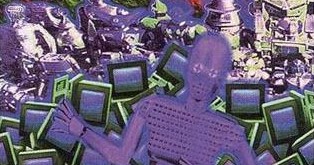|
[Close file]
Did You Know?
Bits and Pieces from the NR Trivia Collection
#11: Liche
by Jens Kreutzer
with support by Nils Kreutzer
Liche is arguably the scariest piece of ice in the whole of Netrunner. Though with the advent of Proteus,
it was relegated to second place in terms of sheer rez cost by Colonel Failure, the Colonel attacks only programs -
while Liche still represents the most brutal attack on the Runner's frontal lobe there is. But admittedly, this toughest
variety of Black Ice has lost somewhat of its glamour since the days when 14 bits in the Corp player's pool was considered
something of a "magic number". Today's streamlined tournament play doesn't leave much room for Black Ice-heavy strategies,
rather investing such large sums of bits in fast advancement. Moreover, Liche is at its best when sprung as a surprise, but
the single widespread strategy that uses big ice these days, Rent-to-Own, rezzes its ice beforehand, negating any surprise.
And so, it is usually Colonel Failure with its five must-break subroutines that ends up getting used in Rent-to-Own, with declassed Liche often serving as a substitute if not enough Colonels are available. After all, brain damage isn't so bad when you see it coming, while getting a program trashed usually means "End the run" if it wasn't the innermost piece of ice.
Where Liche hails from is rather obvious: There is a program of the selfsame name in R. Talsorian's Cyberpunk 2.0.2.0., the roleplaying game that lent its background to Netrunner. In the basic rulebook of Cyberpunk 2.0.2.0. (page 139), it says: "An advanced form of Zombie, Liche also rips away the forebrain [...], but selectively. Most memory is eradicated, leaving enough to implant an easily controlled (by the Referee) pseudo personality into the empty brain. Icon: A metallic skeleton dressed in black robes and wearing a blackend crown. It grabs the Netrunner in its freezing grasp and drags him back under the floor." This description is accurately reflected in the straightforward but very fitting artwork by Mark Poole. However, there's more trivia to it, as Rick Cripe has revealed: "Mark Poole did the illustration for both Liche and the original Counterspell in Magic:The Gathering. If you hold them next to each other, you clearly see that it's the same guy from Counterspell in the Liche illustration."
Now that the card's origin is clear, there remains one perhaps not-so-obvious question: What, precisely, is a "Liche"? We conveniently have, of course, the supposed picture of one right on the card, but let's take a look at where this word comes from (It's hard to find it in the dictionary; plus, you'll never find this "undead" meaning). It's probably safe to say that this skeletal undead fiend made its first appearance in fantasy role-playing games like Dungeons&Dragons, where it is usually portrayed as a former human (often with magical powers) who somehow manages to prolong his (or her) life even beyond death. It resembles a zombie or a vampire in some respects, and is usually a terrible opponent with devastating powers. Somehow one gets the impression that the D&D authors were looking for another scary sort of "living dead" to add to their bestiary, and just made up the name, written initially as "Lich", but also as "Liche" in various other roleplaying games thereafter.
Normally not found in non-dialectal modern English all on its own, the word does appear in compounds like lich-gate (also written as lych-gate) "a church-yard gate with a porch under which a bier may be rested", or lich-house "mortuary". It is therefore only natural to associate lich with death, graveyards and other unpleasant things. These compounds that incorporate lich- are relics from the time of Old English when there still was a word lic (or licaman) meaning "body", pronounced like leech back then. Old English was spoken in England more than 1000 years ago, at which time the related languages English and German were still much closer to each other than they are today.
Taking a look at the other side of the English Channel, the ancient Old Saxon language probably comes close to being their common ancestor (Old Saxon also had a word lic). The later Old High German term lihnamo is closely related to lic, licaman (and therefore, lich) and modern German Leiche, Leichnam, "corpse". Old High German lih and Old English lic originally meant almost exclusively "body" in a general sense, while namo meant "shell, husk, cover, wrap". A corpse (lihnamo, literally "bodily shell") was apparently understood as the discarded shell that the soul left behind when it went on into the afterlife. At some later point, the meaning of lic and its various descendants was narrowed down from referring to "body" in general to meaning only "dead body". By the medieval times of Middle English, when there already were lich and a variant liche (pronounced in two syllables back then) around, they were understood as meaning "corpse" most of the time. Hence, like its lesser cousin Code Corpse, Liche is etymologically just that - a corpse. But one that seems pretty much alive and shambles around, throwing fireballs with abandon. So, Runners, beware!
Of course, if you insisted on going back to ancient times, lich(e) would just mean "body", but then, since corpse comes - via Old French - ultimately from the Latin corpus (also meaning "body"), old buddies Liche and Code Corpse would gang up once again on the poor Runner, etymologically speaking. But before you start asking about the etymology of the word boring, and to finally get away from this somewhat morbid, doom-and-gloomy discussion: A lychee is a kind of fruit grown in southeast Asia, not half as scary as a lich(e), so please don't confuse the two. :-)
[Previous Did You Know]
[Close file]
[Next Did You Know]
|
|
|

